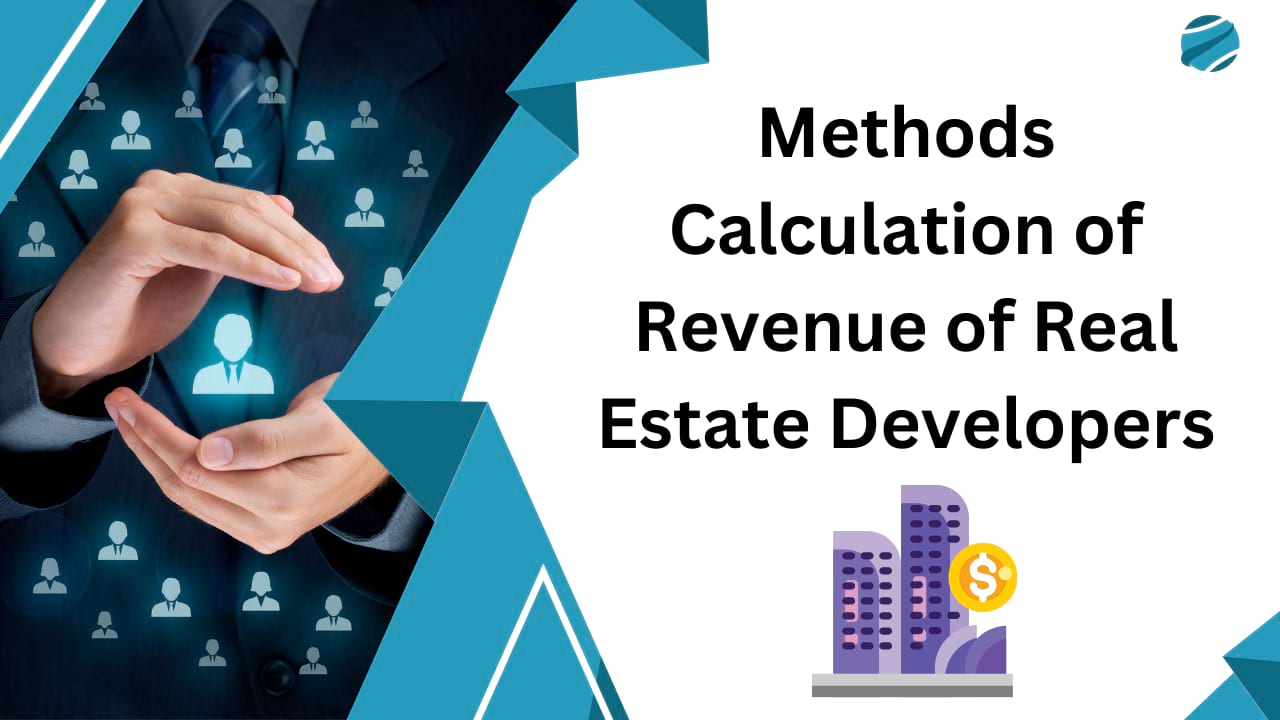Methods Calculation of Revenue of Real Estate Developers, Computation Of Business Income Of Real Estate Developers. The real estate sector is the fastest-growing sector in the country; it provides employment to lakhs of people and has contributed a lot to the exchequer of the Government. Real Estate activity may consist of the development of Townships, Residential Complexes, Commercial or Industrial Complexes, etc. Real Estate projects are long-term projects, that take years to be completed.
The Real estate activities are spread over many years or it takes more than one year to complete a project, thus it involves complex issues while calculating the business income of real estate projects.
The Income Tax Act, 1961 does not provide any specific provisions for revenue recognition of real estate business. The ICAI issued Accounting Standard -09 related to revenue recognition and Guidance Note on Recognition of Revenue by Real Estate Developers in 2006( Revised in 2012).
The ICAI has issued Accounting Standard -07 and related Guidance Note for the accounting of real estate contracts.
The provisions of Sections 28 to 44DB are applicable in case of real estate activity along with other provisions and rules of the Act.
Section 145 of the Income Tax Act, 1961 related to the method of accounting is also relevant for calculating revenue of real estate business.
Quick Links
Methods Calculation of Revenue of Real Estate Developers
Method Of Accounting For Revenue Recognition For Real Estate Developers
(I) Completed Contract Method (CCM)
According to Accounting Standard -09, revenue relating to any, sales transaction is recognized when significant risks and rewards of ownership of goods are transferred.
In the case of real estate business, the sale of immovable property, the ownership of the property is transferred as per the Transfer of Property Act, 1882 when the legal title of ownership is transferred. According to the provisions of the Transfer of Property Act, of 1882 an immovable property is transferred by way of a registered sale deed or according to provisions of Section 53A of the Transfer of Property Act, of 1882.
In the case of the Completed Contract Method, the revenue is recognized, when ownership in the property is transferred. Since the real estate project is a long-term project the property will be transferred when it is completed. In this case, no revenue is recognized in the years when the project is under development and revenue is recognized, when the project is physically completed, possession is handed over and ownership is transferred.
MAIN FEATURES OF THE COMPLETED CONTRACT METHOD (CCM);
- The Revenue is recognized in the financial statements only on completion of the project;
- The consistency of income in the financial statement of the developer will not be the same;
- The income will be recognized on an actual basis;
- No taxable income will be generated during the year when the project is under development;
- The builder or developer may use this method to defer his/their tax liabilities;
- The real estate developer may lose the benefit of Set off Depreciation or Carry Forward Losses due to long period of project and revenue recognition;
- The benefit of Section 80-IB and other incentive provisions and benefits therein may lapse due to long period of project and revenue recognition;
- The tax authorities do not prefer this method of accounting due to deferment of taxes.
(ii) PERCENTAGE OF COMPLETION METHOD (PCM);
Under this method, the revenue is recognized as per the stage of completion of the project on a year-to-year basis during the development of the projects.
The underlying principle for the adoption of the Percentage of Completion Method for revenue recognition is that in the case of a real estate project, generally, significant risks and rewards of ownership of property are transferred to the buyer at the time of entering into a binding sale agreement. Once the sale agreement is entered, the developer effectively acts for the buyer in the capacity of a contractor.
MAIN FEATURES OF THE PERCENTAGE OF COMPLETION METHOD (PCM);
- Revenue is recognized in the financial statements on a year-to-year basis at the end of each year when the project is completed.
- The profit in the developer’s financial statement will be reflected consistently from year to year.
- The revenue is recognized before the property comes into existence and physical possession of property is handed over by developer to the buyer.
- The income is calculated on an estimated basis, considering the total project revenue to be earned and total project expenses to be earned in the future.
Since the Income Tax Act, of 1961 does not provide any specific method for the calculation of the income of real estate developers, so normal provisions related to head business or profession i.e. Sections 28 to 44DB are applicable after considering Accounting Standards 7 and 9, read with “Guidance Note on Accounting for Real Estate Transactions (Revised 2012), issued by ICAI applicable for the accounting year commencing on or after 01.04.2012.
The Court has allowed real estate developers to choose any one of the methods for accounting and recognition of their revenue. They are free to choose CCM or PCM related to old Accounting Standard-07. After 1.04.2003 the Accounting Standard-07 was revised and ICAI issued a guidance note for calculation and accounting of real estate projects.
In the following cases, which are related to the period prior to 1.04.2003 when as per old Accounting Standard-07 applicable in such period the option is available for the assessee to adopt any one of CCM or PCM, still, courts held that the real estate developers should follow the PCM method;
Greater Ashoka Land and Development Company Private Limited V. Asstt. CIT (2001)79 ITD 595(Delhi) (2004)89 TTJ (Delhi) 281, Assessment Year 1988-89, the assessee argued that it has followed one venture of accounting and accordingly, profit in respect of such venture would be determined only in the year in which venture is completed. The Tribunal held that Income accruing one year cannot be deferred to future years by adopting the incorrect method of accounting, with a view to postponing tax liability.
Asstt.CIT V. Prerna Premises (P.) Limited (2006) 7 SOT 288(Mumbai), Assessment years 1988-89, the assessee is a real estate developer who followed the project completion method of accounting. the cases did not recognize revenue on the ground that the construction of the project was not completed. The tribunal held that the Period of Completion of the project cannot be allowed to be stretched at the whims of the assessee. Since 80% of the constructed area had been sold and occupied by the buyer, hence the project was deemed to be completed.
Recommended Articles
- Real Boost, Top 3 Cities to Invest In Real Estate Sector
- Real Estate Bill, 2015 – Amendments in Real Estate Bill, 2013
- TDS Section 194IA – Objectives, Concepts, Rate of TDS
- TDS on sale of Immovable Property – TDS Section 194IA
- Saving Capital Gains from Property – An Insight
If you have any queries or suggestions regarding “Methods Calculation of Revenue of Real Estate Developers” then please tell us via below comment box…







